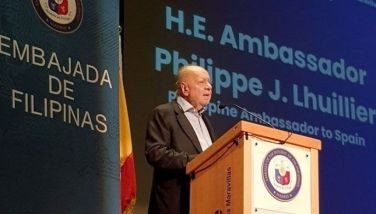Why not a bus rapid transit system?

Frustration over the worsening traffic conditions at EDSA is building up as shown by the number of ideas and suggestions being offered to those who can do something to resolve it. Today we are featuring the idea of introducing the use of a bus rapid transit system.
Reacting to another reader’s suggestion on how to solve the perennial EDSA traffic problem, Andy Reyes writes:
“Your reader’s suggestion to have a brand-coding system in lieu of the number coding system would be more difficult to implement. Recognizing the brand would require more training for the traffic enforcers. The quantity per brand would be unequal and would entail user resistance.
“It is just substituting one simple number coding scheme with another more difficult coding scheme. Mainly it does not offer mass transportation advantages like MRT and LRT, or my suggestion – the BRT.
“A medium to long term solution would be to implement a Bus Rapid Transit System (BRT) similar to that implemented in Brazil.
“Also phase out the jeepney and FX as these are not suitable for mass rapid transit systems in busy urban areas. Increase the number of trips of the LRT and MRT.â€
Tried and tested
Reyes cites the experience of several countries that have embraced the BRT to improve their public transport and consequently solve their traffic problem. He adds that the BRT in Quito, Ecuador can be done in the Philippines.
“First developed in Curitiba, Brazil by former mayor Jaime Lerner, PhD and then expanded and first implemented in a large capital city in Bogotá, Colombia by former mayor Enrique Peñalosa, PhD, the concept of the Bus Rapid Transit system is essentially the concept of an MRT or LRT system “on rubber wheels,†physically separating the center lanes of multi-lane highways and main thoroughfares from mainstream traffic to be dedicated only to specially-designed, high-capacity, high-quality, clean and comfortable buses, along with attractive, high-quality, and comfortable bus stations with advanced fare-collection systems to speed up boarding and alighting times.
“All these features are meant to attract more and more citizens to use public transport and use less private vehicles in order to lessen traffic congestion and hopefully lessen the air pollution in major cities in the Philippines.
Not expensive to replicate
“Instead of spending astronomical amounts of money on making subways (the most expensive public transport systems) or elevated railways (much cheaper than subways but still extremely expensive), BRT systems improve on and make use of existing road infrastructure in creating a public transportation system that can be deployed at a small fraction of the cost and time it takes to deploy an elevated LRT/MRT system or an underground subway.
“Instead of relying on expensive trains, BRT makes use of less expensive buses (usually accordion-type articulated buses for higher passenger capacity) which are easier to deploy, and provide ready employment opportunities to absorb already-skilled bus drivers.
“In addition to the main “trunk-lines†where these higher-capacity accordion-type articulated buses are deployed, normal-sized buses are made to ply all support routes as feeder-buses which function like normal curb-side buses, not separated by special barriers.
“Most BRT systems recommend that these feeder-bus routes be free of charge, with drivers earning fixed wages and whose operation is to be funded from the fares taken from the main trunk-lines.
No boundary system
The benefit of Bogotá’s TransMilenio BRT system which Dr. Peñalosa developed, to the overall development of Bogotá and its improvement on the quality of life of its citizens, is instructive to the Philippine situation as Bogotá used to be plagued by the exact same problems that are found in the extremely chaotic Philippine bus and jeepney system.
“No different from the Philippine ‘boundary system,’ Bogotá used to have to grapple with the ‘Guerra del centavo’ which always resulted from the ‘boundary system’ that was used in Bogotá where a driver’s pay is based on the number of passengers he gets instead of getting decent fixed wages so that he would drive on schedule instead of crowding at bus stops while waiting for passengers to fill the bus up, fighting with other buses for passengers, making sudden dangerous swerves just to strategically get to the crowded part of the bus stop where most passengers would be waiting.
“Right after the shift from the chaotic Philippine-like boundary system that was formerly in place in Bogotá to the introduction of the TransMilenio BRT system, everything changed for the better.
“More and more people, including a large percentage of well-to-do car owners, decided to regularly take the TransMilenio BRT system to get from point A to point B as it was much faster and generally cheaper, using their cars only for the few times that they needed to carry heavy loads (such as shopping for groceries or other errands).
“Dr. Peñalosa even devised a scheme where the numerous small bus companies (as well as the bus drivers who worked for those companies) that used to dominate Bogotá’s public transport system were co-opted and absorbed into becoming part of a larger cooperative-like corporation that operates TransMilenio, so that instead of these bus operators losing their original incXome, they became an integral part of the newer BRT system and now actually even make more profits than in the past as TransMilenio’s higher capacity, higher levels of ridership, and shared costs of maintenance and operation gave it the economies of scale increasing the individual profitability of those different bus operators who have since become TransMilenio shareholders.
Outstanding success
“The outstanding success of the Bus Rapid Transit concept in both Curitiba and Bogotá got numerous other cities in Latin America learning from them, and eventually, even first world cities like Brisbane have decided to adopt it.
“The BRT craze has even caught the attention of the Institute for Transportation & Development Policy, the UN Environmental Program, the Hewlett Foundation, and the German Society for Technical Cooperation, as any scheme that promotes an efficient form of public transportation has been proven to greatly reduce emissions and carbon footprint regardless of whether the vehicles themselves run on petroleum-based fuel.
“At latest count, Cebu City, Davao City, and Baguio all have plans to implement Bus Rapid Transit in the Philippines in order to develop their public transportation systems and slowly phase-out the largely informal and inefficient bus and jeepney systems that have hobbled economic progress.
“For P-Noy to become successful as a transformative president, he definitely should spearhead the adoption of the BRT concept not just in Metro Manila, but also all throughout the country especially in all major cities.
“After all, the development of a high-quality public transport system not only contributes to rapid economic development, it also contributes greatly to the reduction of air pollution and a greatly-improved quality of life for Filipinos.
“It just requires genuine and strong political will and public and transport sector support.â€
Facebook and Twitter
We are actively using two social networking websites to reach out more often and even interact with and engage our readers, friends and colleagues in the various areas of interest that I tackle in my column. Please like us at www.facebook.com and follow us at www.twitter.com/ReyGamboa.
Should you wish to share any insights, write me at Link Edge, 25th Floor, 139 Corporate Center, Valero Street, Salcedo Village, 1227 Makati City. Or e-mail me at [email protected]. For a compilation of previous articles, visit www.BizlinksPhilippines.net.
- Latest
- Trending



























